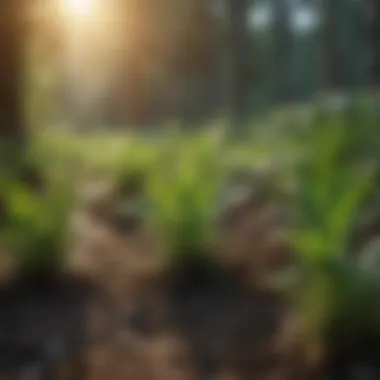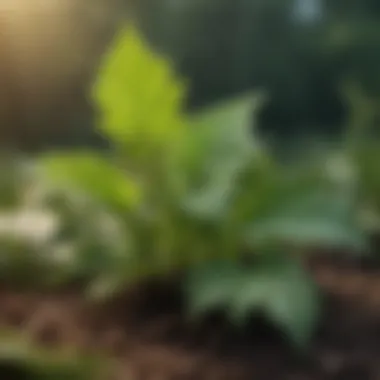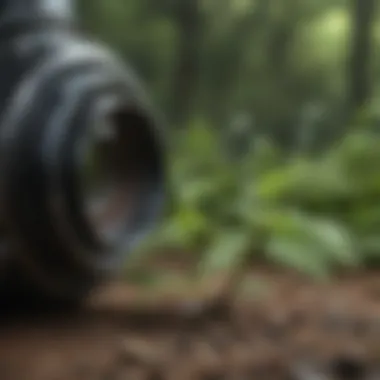Effective Strategies for Managing Stinging Nettle Growth in Gardens


Overview of the Topic
Current Status and Challenges
The current state of stinging nettle proliferation poses significant challenges for gardeners and land managers. With its ability to quickly overtake an area, stinging nettle disrupts native plant species and can be harmful to humans upon contact. The persistent nature of stinging nettle makes it a formidable foe, requiring strategic interventions to prevent its uncontrolled growth.
Sustainable Solutions
To address the challenges posed by stinging nettle, implementing sustainable management practices is crucial. Utilizing eco-friendly methods such as manual removal, mulching, and natural herbicides can help control the spread of this invasive plant species. Through showcasing successful case studies and effective resource management techniques, readers can gain valuable insights into mitigating the impact of stinging nettle on ecosystems and communities.
Impact and Importance
The unchecked proliferation of stinging nettle can have detrimental effects on local ecosystems and communities. By analyzing the impact of this prickly plant on biodiversity and human health, individuals can recognize the importance of conservation efforts and sustainable resource management. Emphasizing the significance of curbing the spread of stinging nettle underscores the necessity of adopting responsible practices to preserve natural habitats for future generations.
Introduction
Stinging nettle, a common nuisance in gardens and landscapes, poses a significant challenge for both amateur and seasoned gardeners. This comprehensive guide aims to equip readers with effective strategies for containing and managing the relentless growth of this prickly plant. By delving into the intricacies of stinging nettle's characteristics, growth patterns, and impact on surrounding vegetation, this article sets the foundation for understanding the necessity of implementing eco-friendly control methods.
Understanding Stinging Nettle
Characteristics of Stinging Nettle
Stinging nettle, scientifically known as Urtica dioica, boasts a plethora of sharp stinging hairs on its leaves and stems, causing skin irritation upon contact. These fine hairs inject histamine and other chemicals upon contact, leading to skin irritation, making it both a fascinating and formidable opponent in garden settings. The plant's ability to thrive in diverse environmental conditions and rapidly spread makes it a resilient weed that demands careful attention and management.
Growth Patterns
The growth patterns of stinging nettle exhibit remarkable vigor, characterized by rapid proliferation and an extensive root system. Its perennial nature allows it to regrow vigorously each season, creating dense patches that outcompete surrounding vegetation. This aggressive growth habit underscores the urgency of implementing rigorous control measures to prevent its unchecked expansion and subsequent domination of the landscape.
Impact on Surrounding Vegetation
Stinging nettle's invasive nature poses a significant threat to the biodiversity of surrounding vegetation. By forming dense thickets, it competes for essential resources such as sunlight, water, and nutrients, compromising the growth and survival of other plant species. Its presence can lead to the displacement of native flora, further emphasizing the critical need for proactive management strategies to mitigate its adverse effects.
Why Control is Essential
Potential Harm to Humans


The stinging hairs of nettle plants contain chemicals that trigger allergic reactions upon contact with human skin, causing symptoms ranging from itching and redness to more severe rashes. The potential harm posed by stinging nettle emphasizes the importance of implementing control measures to minimize human exposure and prevent discomfort or adverse reactions.
Ecosystem Disruption
In addition to its impact on humans, stinging nettle can disrupt ecosystems by outcompeting native plant species and altering local biodiversity. The unchecked spread of nettle populations can lead to imbalances in ecological communities, affecting the dynamics of plant and animal interactions. By acknowledging the broader ecological implications of nettle infestations, it becomes clear why establishing robust control strategies is imperative for preserving ecosystem health and diversity.
Natural Control Methods
When it comes to addressing the issue of stinging nettle in gardens and landscapes, the utilization of natural control methods plays a vital role. these approaches not only promote eco-friendly practices but also offer long-term solutions that are beneficial for both the environment and human health. One essential aspect to consider is the efficacy of these methods in controlling the spread of stinging nettle while minimizing the use of harmful chemicals. By integrating natural control methods into the management strategy, individuals can maintain a healthy balance in their ecosystems.
Manual Removal Techniques
Using Protective Gear
In the realm of manual removal techniques for stinging nettle, the importance of utilizing protective gear cannot be overstated. Gear like gloves and protective clothing serves as a shield against the plant's stinging hairs, safeguarding individuals from potential skin irritations and allergic reactions. The key characteristic of using protective gear lies in its ability to provide a physical barrier between the individual and the nettles, ensuring a safe and efficient removal process. This choice is considered popular and essential in the context of this article due to its role in promoting safety and minimizing risks. However, one potential disadvantage of using protective gear is the additional cost and effort required to acquire and maintain these items.
Root Extraction
Another vital aspect of manual removal techniques is root extraction, which involves uprooting the entire plant to prevent regrowth. Root extraction is particularly effective in controlling stinging nettle as it disrupts the plant's ability to propagate and spread. The key characteristic of root extraction is its comprehensive approach to eliminating the plant from the root level, ensuring long-term control. This method is a beneficial choice for this article due to its ability to address the root cause of the issue, thereby leading to more permanent results. One advantage of root extraction is its environmental friendliness, as it reduces the need for chemical intervention; however, a potential disadvantage is the physical effort required for thorough uprooting.
Mulching and Smothering
Organic Mulches
In the realm of mulching and smothering techniques for stinging nettle management, organic mulches emerge as a sustainable and effective option. Organic mulches like wood chips or straw provide a natural barrier that inhibits the growth of stinging nettle by blocking sunlight and access to nutrients. The key characteristic of organic mulches lies in their ability to suppress weed growth while enriching the soil as they decompose, promoting overall soil health. This choice is popular and beneficial for this article due to its dual functionality of weed control and soil improvement. One advantage of organic mulches is their biodegradability, contributing to a healthier ecosystem; however, a potential disadvantage is the need for periodic replenishment to maintain efficacy.
Plastic Coverings
Alternatively, plastic coverings present a different approach to mulching and smothering stinging nettle. Plastic coverings create a physical barrier that prevents sunlight penetration, inhibiting weed growth, including stinging nettle. The key characteristic of plastic coverings is their durability and long-lasting effects in weed suppression, providing a low-maintenance solution for gardeners. This choice is beneficial for this article as it offers a cost-effective and time-saving method for weed control. One advantage of plastic coverings is their ability to retain soil moisture and warmth, supporting plant growth; however, a potential disadvantage is the non-biodegradable nature of plastics, which may pose environmental concerns.
Beneficial Companion Planting
Plants that Deter Nettle Growth
When considering beneficial companion planting for stinging nettle control, selecting plants that naturally deter nettle growth can be advantageous. Certain species like mint, lavender, or marigold emit scents or substances that repel stinging nettle, inhibiting its expansion. The key characteristic of these deterrent plants is their ability to create a protective barrier around desirable crops, preventing stinging nettle encroachment. Choosing plants that deter nettle growth is a popular and effective choice for this article due to its organic and chemical-free approach to pest management. One advantage of these plants is their multifunctionality, serving both as ornamental additions and pest deterrents; however, a potential disadvantage is the need for regular maintenance and monitoring to ensure efficacy.


Interplanting Strategies
In addition to deterrent plants, implementing interplanting strategies can further enhance the effectiveness of companion planting for stinging nettle management. Interplanting involves strategically placing compatible plant species together to maximize space utilization and pest control benefits. The key characteristic of interplanting strategies is their ability to create a diverse and balanced ecosystem that naturally regulates pest populations like stinging nettle. This choice is a beneficial and popular option for this article as it encourages biodiversity and ecological resilience in garden settings. One advantage of interplanting strategies is their promotion of natural pest control mechanisms, reducing the reliance on chemical interventions; however, potential disadvantages may include the need for proper plant compatibility research and management considerations.
Chemical Control Options
Chemical control options play a pivotal role in effectively managing stinging nettle. When dealing with a resilient plant like stinging nettle, using herbicides can provide a strategic advantage in curbing its growth. These options can be instrumental in situations where manual removal or natural methods prove insufficient. By understanding the benefits and considerations associated with chemical control, gardeners and land managers can make informed decisions on how best to address stinging nettle infestations.
Herbicide Application
Herbicide application is a crucial aspect of chemical control options when combatting stinging nettle. Selective and non-selective herbicides offer different benefits and considerations depending on the situation at hand.
Selective vs. Non-Selective Herbicides
Selective herbicides target specific types of plants while leaving others unharmed, making them an ideal choice when dealing with stinging nettle in proximity to desirable vegetation. On the other hand, non-selective herbicides are designed to eliminate all plant growth in the targeted area, which can be more effective in large-scale nettle control efforts but may require careful application to prevent unintended damage to surrounding plants.
Application Best Practices
Implementing proper application techniques is essential for the effective use of herbicides in stinging nettle management. Ensuring the correct concentration and timing of application, as well as using appropriate safety gear, are vital considerations when utilizing herbicides. Furthermore, understanding the specific requirements of the selected herbicide and following manufacturer guidelines can enhance the efficacy of the treatment.
Organic Herbicidal Alternatives
For those seeking eco-friendly alternatives, organic herbicidal options present viable solutions for stinging nettle control.
Vinegar Solutions
Vinegar solutions offer a natural and safe method for combating stinging nettle. The acetic acid present in vinegar acts as a desiccant, effectively dehydrating and killing the plant upon application. While vinegar solutions are biodegradable and pose minimal risk to the environment, repeated applications may be necessary for sustained control.
Essential Oil Sprays
Essential oils, such as clove or citrus oils, can serve as effective herbicidal agents against stinging nettle. These natural alternatives disrupt the plant's cellular structure, leading to wilting and eventual demise. While organic herbicidal alternatives may take longer to show results compared to conventional herbicides, they offer a safer and environmentally friendly approach to stinging nettle management.
Long-Term Management Strategies
In this comprehensive guide focusing on controlling stinging nettle, the significance of long-term management strategies cannot be overstated. Implementing effective long-term techniques is crucial in curbing the spread of stinging nettle and maintaining a healthy garden or landscape. By incorporating sustainable practices and addressing underlying issues, long-term management strategies ensure lasting results and minimize the need for continuous intervention.


Soil Amendments and Fertilization
Optimizing Soil Health
Optimizing soil health plays a pivotal role in the successful management of stinging nettle. By enhancing soil quality through beneficial amendments, such as compost and organic matter, gardeners can create an environment that discourages the growth of unwanted plants like stinging nettle. The key characteristic of optimizing soil health lies in its ability to promote robust plant growth while naturally suppressing weed proliferation. This proven method not only enriches the soil but also fosters a resilient ecosystem that is less susceptible to invasive species.
Nutrient Balancing
Nutrient balancing is a fundamental aspect of soil management when combating stinging nettle infestations. Balancing essential nutrients, such as nitrogen, phosphorus, and potassium, ensures that plants receive optimal nourishment while preventing an overabundance of nutrients that may favor weed growth, including stinging nettle. The unique feature of this approach lies in its ability to create a harmonious soil environment that promotes the overall health and vitality of desired plant species without inadvertently fueling the spread of unwanted weeds like stinging nettle.
Monitoring and Early Intervention
Regular Inspections
Regular inspections are a cornerstone of effective stinging nettle control strategies. By routinely examining the garden or landscape for signs of stinging nettle growth, gardeners can proactively identify and address issues before they escalate. The key characteristic of regular inspections is the ability to detect stinging nettle populations in their early stages, allowing for targeted and timely intervention. This systematic approach not only prevents widespread infestations but also reduces the need for drastic measures to combat established colonies.
Prompt Action
Prompt action is essential in the battle against stinging nettle intrusion. Upon identifying stinging nettle presence, immediate and decisive measures must be taken to prevent further spread and mitigate potential damage. The key characteristic of prompt action lies in its responsiveness and efficiency, addressing stinging nettle outbreaks swiftly and effectively. This proactive approach helps maintain control over infestations and preserves the integrity of the surrounding ecosystem.
Integrated Pest Management (IPM)
Comprehensive Approach
Integrated Pest Management (IPM) offers a comprehensive and sustainable approach to stinging nettle control. By integrating various control methods, such as cultural, mechanical, and biological strategies, IPM seeks to manage pest populations while minimizing environmental impact. The key characteristic of this approach is its holistic nature, considering the ecosystem as a whole and emphasizing long-term pest management solutions. By adopting an IPM approach, gardeners can effectively reduce stinging nettle prevalence while promoting ecological balance.
Reducing Reliance on Chemicals
Reducing reliance on chemicals is a key objective of sustainable stinging nettle management. By decreasing the use of synthetic pesticides and herbicides, gardeners can minimize chemical residues in the environment and safeguard beneficial organisms. The unique feature of this approach is its emphasis on eco-friendly alternatives, such as cultural practices and biological controls, which offer effective stinging nettle suppression without detrimental effects on the ecosystem. By reducing chemical dependency, gardeners can foster a healthier and more resilient environment for both plants and wildlife.
Conclusion
In the realm of managing stinging nettle, the Conclusion section plays a pivotal role in encapsulating the essence of the entire discourse presented in this comprehensive guide. It serves as the compass that directs readers towards implementing effective strategies to combat this proliferating nuisance. By synthesizing the plethora of information discussed throughout the article, the Conclusion not only reinforces the significance of its contents but also offers actionable insights for mitigating the encroachment of stinging nettle in gardens and landscapes.
Summarizing Effective Strategies
Combining Methods for Optimal Control
Delving into the realm of Combining Methods for Optimal Control, we unravel a strategic approach that harmonizes various techniques to achieve unparalleled efficacy in stinging nettle management. This method advocates the integration of manual removal, mulching, companion planting, and other control avenues to deliver a comprehensive solution. By synergizing these diverse methodologies, individuals can not only curtail the growth of stinging nettle but also prevent its resurgence, establishing a formidable defense against its persistence. The adaptability and versatility of Combining Methods for Optimal Control make it a preferred choice in this narrative, offering a multi-faceted approach to tackling the invasive tendencies of stinging nettle. However, it is essential to highlight the meticulous planning and diligent execution required for this strategy, as improper implementation may lead to subpar results or ineffective management.
Sustainable Practices for Long-Term Results
Transitioning towards Sustainable Practices for Long-Term Results, we unearth a paradigm shift towards eco-conscious methodologies that foster enduring solutions to the stinging nettle predicament. This approach advocates for practices that not only address the immediate concerns but also cultivate a sustainable environment for prolonged efficacy. Emphasizing aspects such as soil health optimization, companion plant selection, and integrated pest management, Sustainable Practices for Long-Term Results lay the foundation for a holistic and enduring control strategy. The crux of this method lies in its emphasis on long-term sustainability, steering away from quick-fix solutions towards a more enduring and environmentally responsible approach. Nonetheless, it is imperative to acknowledge the meticulous planning and consistent efforts required to uphold these practices, as they demand dedication and perseverance to yield lasting results in stinging nettle control.



